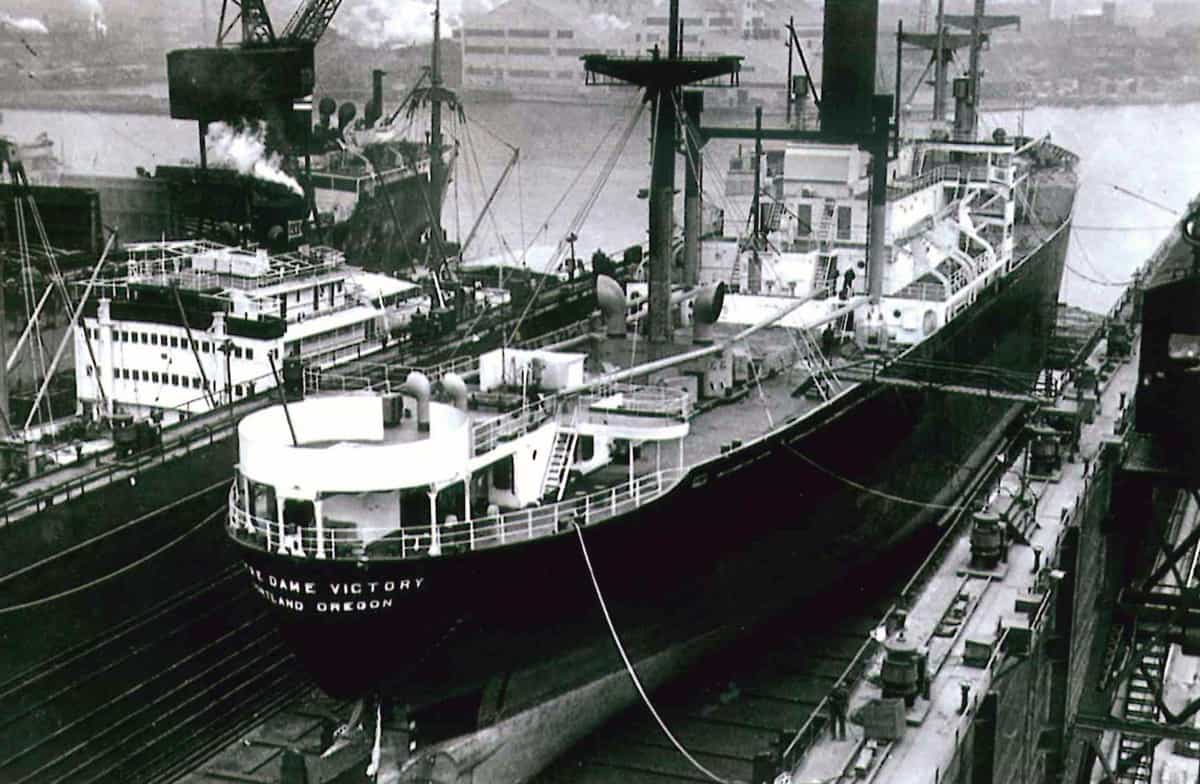FreightWaves Classics is sponsored by Old Dominion Freight Line — Helping the World Keep Promises. Learn more here.
This story was originally published on Dec. 2, 2019.
College football kicked off more than 150 years ago with Rutgers University defeating Princeton University 6-4 in that first game in 1869.
With football season in full swing, this is an appropriate time to focus on a few U.S.-flag ships that invoke the spirit of college football. The first ships to come to mind feature two collegiate rivals, Harvard and Yale universities, of the American Line.
Both twin-screw-propelled vessels were built in Glasgow, Scotland, in 1888 and 1889, respectively, as the City of New York and City of Paris. They measured 560 feet in length and were the first ships to exceed 10,000 tons (not counting the Great Eastern). They were also “Blue Riband” holders and able to steam at over 20 knots.
In 1893, American Line purchased the two ships, placed them under the U.S. flag and shortened their names to New York and Paris. On April 14, 1898, the U.S. Navy requisitioned both ships and renamed them USS Harvard and USS Yale. They were then fitted out as auxiliary cruisers for the Spanish-American War.

When the students at Yale heard about this, they conducted a fundraiser to purchase guns for their namesake ship. They soon raised enough money to buy and install two 6-pounders, which they named Eli (in honor of the school’s founder, Elihu Yale) and Handsome Dan (the Yale bulldog mascot) to distinguish them from the other batteries.
The ships were fitted with eight 5-inch guns and six 6-inch guns. Both Harvard and Yale served gallantly in the Caribbean and were returned to their owners later that year.
Then there were the famous 24-knot coastal liners: the Harvard and Yale of 1907.
Both were built at Roach’s Shipyard in Chester, Pennsylvania. They were identical in every detail except for their interiors, where they took on the decor and trimmings of their respective names. The Yale featured school-color blue decor and stained glass, while the Harvard featured the school color of crimson.

They were built for the overnight service from New York to Boston but wound up on the West Coast, plying an overnight route from San Francisco to Los Angeles and San Diego. Both ships distinguished themselves during World War I, serving as cross-English Channel troop transports before returning to their West Coast routes.
During World War II, many Victory class ships were named after American colleges and their football teams.
One of those was the 8,500-horsepower Notre Dame Victory. Built in Portland, Oregon, in 1945, it was operated worldwide by the Interocean Steamship Co. for the U.S. government. Shortly thereafter, Moore-McCormick Lines chartered the ship for its South American service. Upon receiving modern C-2 and C-3 class ships, the Notre Dame Victory was returned to the U.S. government and laid up in the James River Reserve Fleet.

In 1950, the U.S. Office of Defense Mobilization, recognizing an increasing need for steel, requested the American steel industry to increase production. Cleveland-Cliffs Iron Co., the oldest of the Michigan ore mining operators, needed to obtain a ship quickly. At the time, all the shipyards on the Great Lakes were busy.
The decision was made to purchase the Notre Dame Victory from the U.S. government and lengthen and convert the ship to a Great Lakes ore carrier. Cleveland-Cliffs, Bethlehem Steel Shipyards in Baltimore and the Army Corps of Engineers made maritime history as they developed a plan to convert the ship by cutting it at the No. 3 hatch and inserting a new 165-foot midsection.
The ship would then be towed to New Orleans and up the Mississippi and Illinois rivers leading to the Chicago River and through the city to Lake Michigan. The transit of the Chicago River proved most hazardous. The ship had to be taken around sharp bends and proceed through several simultaneously raised bridges through the center of Chicago.

Before its departure from Baltimore, two 120-foot pontoons were fitted to increase the waterplane, so the draft of 8 feet, 6 inches could be maintained for the river transit but also available to be ballasted to get under certain bridges. Since this was the largest vessel to transit the rivers, radio stations announced its progress and thousands of people gathered along the shores to watch it pass.
On May 9, 1951, the ship arrived at Chicago and work immediately commenced lifting deckhouses, masts and the smokestack into position. The propeller and rudder were fitted and on June 2 the ship commenced its sea trials. On June 4, renamed the Cliffs Victory, the ship proceeded to its first load port.

Thus, the first ocean cargo vessel to be converted to a Great Lakes ore carrier started life as the Notre Dame Victory. The conversion took an amazing 167 days.
In 1956, the ship was again lengthened another 96 feet, increasing its total to 713 feet and deadweight tonnage to 18,175. It was considered the longest and fastest ship on the Great Lakes. The ship enjoyed a long life until being sold in 1985 to South Korean scrappers.

Other notable World War II Victory ships to bear the names of American colleges included the Kings Point Victory, Princeton Victory, Rutgers Victory and about 100 more. After the war, another Kings Point was built as a tanker in 1958, and a 1973-built tanker became the second Notre Dame Victory. Central Gulf Lines named its flagships the Green Wave in honor of the founders’ alma mater, Tulane University in New Orleans.
FreightWaves Classics articles look at various aspects of the transportation industry’s history. Click here to subscribe to our newsletter!
Have a topic you want us to cover? Email [email protected].










